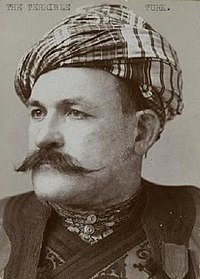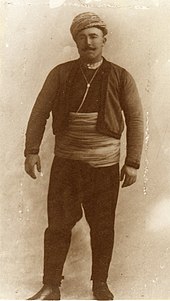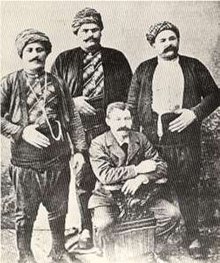Yusuf Ismail
| Yusuf Ismail |
|
|---|---|
|
Yusuf Ismail |
|
| Nationality: |
|
| Date of birth: | 1857 |
| Place of birth: | Karalar near Shumen , Eyâlet Silistra , Ottoman Empire |
| Date of death: | 4th July 1898 |
| Place of death: | near Nova Scotia |
| Size: | 1.88 |
| Weight class: | Heavyweight |
Yusuf Ismail ( 1,857 in Karalar in Shumen - 4. July 1898 , off the coast of Nova Scotia ), and Yussuf Ishmaelo was a pro - wrestler Turkish origin from the Ottoman Empire (from 1878 Bulgaria ), who in the 1890s in Europe and the USA when Yusuf Ismail the Terrible Turk took up fighting. The author Rıza Tevfik gave him the name Koca (the great) posthumously , which is why he became known as Koca Yusuf in later years . In 1898 he was killed in the sinking of La Bourgogne .
biography
Early career and the "Turkish invasion"
Little is known about the childhood and youth of Yusuf İsmail's wrestling career in 1894. According to the Scottish wrestling historian William Baxter, he was born in 1857 as Yussuf Ishmaelo in what is now Bulgaria .
Ismail was first known when he won the Turkish oil wrestling tournament in 1887 . Edmond Desbonnet writes in his book Les Rois de la Lutte from 1910 that the so-called "Turkish invasion" began in 1894 when the French wrestler Joseph Doublier, who had previously brought two Turkish wrestlers to Paris, toured Turkey and with three other wrestlers returned to France: Kara Osman, Nurullah Hasan and Yusuf Ismail. On his debut in Paris, İsmail defeated the wrestler Sabés in four seconds.
Yusuf İsmail spent the next three years in France, where he dominated the wrestling scene. When his competitors Antonio Pierri and Tom Cannon wanted to present a wrestler who would beat İsmail, he reportedly announced that he would cut his throat if he was ever hit. The fight against his compatriot Ibrahim Mahmut in the Cirque d'Hiver in Paris was described as "the most brutal competition ever seen on the mat". Ismail became so enraged during the fight that he pulled Mahmut's nostrils , broke his ribs, and twisted his arms. Although referee Tom Cannon tried to break off the fight, it was only after the intervention of several police officers and spectators that the two fighters were able to be separated. Originally, Kara Osman was intended to be the opponent of Ismail, but he had reported sick, which is why Mahmut had taken his place. Rumors said that Osman had withdrawn from the fight because he feared for his life over a dispute between him and Ismail.
Stay in the USA
After being unbeaten for four years, İsmail successfully challenged the US wrestler Evan Lewis to fight for the American heavyweight championship in 1898. He was announced as "The Terrible Turk", a fighting name that was later given to other wrestlers. İsmail traveled to the United States, where he caused a stir with flowing robes and a colossal appetite.
At the London Theater in New York, İsmail's manager William A. Brady promised 100 dollars as a reward to every man who stood in the ring with İsmail for more than 15 minutes . George Bothner, a well-known lightweight wrestler, was the only one who accepted this request, even though İsmail weighed 114 kilograms, around 50 kilograms more than him. Bothner claimed that "there is no living man who can put him down on his back in 15 minutes" and believed that İsmail, like many other "so-called horrors", was just a show-off. İsmail, on the other hand, believed when he saw his lightweight opponent that they wanted to make a mockery of him. Despite his fearlessness, Bothner was defeated by İsmail a few days later, and he suffered a neck injury. Years later he described his encounter with İsmail in the book From Milo to Londos (1936):
“The Turk picked me up as if I was a kitten. Never before have I felt such terrible strength. Before I could give a wiggle or squirm he dashed me down on the boards with terrific force… They told me that after I had landed, Youssuf rolled me over with his foot, looked out over the audience, gave a contemptuous snort and walked off the stage. When I came to, I was a sadder, but wiser young man. Somehow or other I got into my clothes, hobbled out into the street and started to walk up Third Avenue towards my home. Youssuf had given my neck such a wrench that he almost tore it from my shoulders. It was several days before I could look in the direction I was headed. "
“The Turk picked me up as if I were a kitten. I had never before experienced such terrible strength. Before I could move or squirm, he threw me onto the boards with tremendous force ... I was told that Yusuf turned me with his foot after I landed, looked at the audience, snorted contemptuously and walked off the stage. When I came to, I was a sadder but wiser young man. Somehow I got dressed, hobbled out into the street, and headed home on Third Avenue. Youssuf had twisted my neck so that it almost ripped it off my shoulders. It took several days before I could look in the direction I was going. "
On March 26, 1898 Ismail was in a competition in Madison Square Garden against the champion in Greco-Roman wrestling , the German-American Ernest Roeber , disqualified . Ismail pushed Roeber out of the raised ring and dropped him upside down on the floor. Roeber was unconscious for several minutes, and many onlookers believed he was dead. They wanted to storm the ring but were stopped by police officers. Roeber was declared the winner. On April 30th, a rematch took place in the Metropolitan Opera , but it also ended in riot. The management of the opera house then decided not to let wrestling matches take place there. A few months later, Ismail defeated the wrestler Evan "Strangler" Lewis at the American heavyweight championship in Chicago . Lewis couldn't hold his own against İsmail, nor was he able to use his famous Rear Naked Choke (throttle grip).
Ismail, of a simple and suspicious nature, had his prize money paid out in gold and kept the coins in a money belt that he never took off. Since he was very stingy and displayed "animal manners", he did not make many friends in the USA. Brady's colleague T. W. Bert reported: “For if there was anything in the world he liked besides money, it was eating and drinking. He must have eaten ten times every day, and one of his meals would have been enough to feed me for a whole week. ”(“ If there was anything else that interested him besides money, it was the food and drink ate something ten times a day, and one of his meals was so rich that I could have fed on it for a week. ”) Baxter emphasized that İsmail was not a“ monster ”but an uneducated farmer who“ cheated on America “Has been. He was just a tool for promoters who wanted to make quick money.
death

Shortly after his victory over Lewis, Yusuf Ismail took the first ship back to Europe, where he was reportedly planning to open a cafe or bazaar shop in his home village near Shumen . He was one of around 600 passengers on the La Bourgogne , which sank off the coast of Nova Scotia on the morning of July 4, 1898 after colliding with another ship. 565 people were killed, including Yusuf İsmail. According to survivors, İsmail “behaved like a wild animal” and tried to fight his way through with a dagger in hand. When İsmail reached the railing, a lifeboat was being lowered. Despite warnings from the crew , he jumped and capsized the boat with its passengers. He himself fell into the sea and is said to have been immediately pulled under the water by the weight of his money belt, which is said to have contained gold coins with a value of 8,000 to 10,000 dollars, and he drowned.
memory
In 2001 Turkey issued a commemorative coin with the portrait of Koca Yusuf . In 2016, a museum was opened in the former home of Yusuf İsmail alias Koca Yusuf, in front of which there is a bust of him. An oil wrestling tournament is held annually in his honor. A large floating crane that was handed over to Turkey by the USA in 1952 as part of the Marshall Plan was given the name Koca Yusuf .
The Turkish film Koca Yusuf was released in 1966, and another film is to be launched in 2020.
literature
- Robert H. Davis / Irvin S. Cobb: Over My Left Shoulder: A panorama of Men and Events, Burlesques and Tragedies, Cabbages and Kings and Sometimes W and Y . D. Appleton and Company, New York 1926 (English).
- William A. Brady: Showman . EP Dutton & Co., New York 1937 (English).
- Graeme Kent: Pictorial History of Wrestling . Littlehampton Book Services, 1968, ISBN 978-0-600-03109-3 (English).
- Graeme Kent: The Strongest Men on Earth: When the Muscle Men Ruled Show Business . Robson Press, 2001, ISBN 978-1-84954-371-2 (English).
- Halil Delice: Koca Yusuf: Yalnizca Güle Yenildi . Babiali Kültür Yayinciligi, 2005, ISBN 978-975-8486-88-5 (Turkish).
- Greg Oliver / Steven Johnson: The Pro Wrestling Hall Of Fame: The Storytellers (From the Terrible Turk to Twitter) . ECW Press, Canada, 2019, ISBN 978-1-77041-502-7 (English).
Web links
- Terrible Turk. In: The Internet Wrestling Database. July 4, 2018, accessed March 17, 2020 .
Individual evidence
- ↑ Ender Bilar: Tarih, cool door - sanat kenti Edirne. P. 262 ( limited preview in Google Book search).
- ↑ a b c d e f Graham Noble: The life and death of the terrible turk. In: eurozine.com. May 23, 2003, accessed March 17, 2020 .
- ^ A b Axel Saalbach: Youssuf The Terrible Turk. In: genickbruch.com. February 19, 2020, accessed March 18, 2020 .
- ^ A b Jordan sprachman / Bill Shannon: This Day in New York Sports . Sports Publishing LLC, Champaigne, Illinois 1998, ISBN 1-57167-254-0 , pp. 86, 121 .
- ^ Walter Camp : The Substitute: A Football Story . D. Appleton and Company, New York 1909, pp. 123-125 .
- ^ Greg Oliver / Steven Johnson: The Pro Wrestling Hall of Fame. ( limited preview in Google Book search).
- ↑ 2001 Koca Yusuf-Madeni: Gümüş. In: gokcemuzayede.com. Retrieved March 18, 2020 (Turkish).
- ^ Mete Ersöz: Koca Yusuf Museum was opened in Bulgaria. In: diplomatikgozlem.com. November 27, 2016, accessed March 19, 2020 .
- ↑ Koca Yusuf, Haliç'te battı - Deniz Kartalı. In: denizkartali.com. April 3, 2018, accessed March 19, 2020 (Turkish).
- ↑ Koca Yusuf (1966) - IMDb. In: imdb.com. Retrieved March 18, 2020 .
- ↑ Koca Yusuf. In: beyazperde.com. Retrieved March 18, 2020 .
| personal data | |
|---|---|
| SURNAME | Yusuf Ismail |
| ALTERNATIVE NAMES | Yussuf Ishmaelo; Yusuf Ismail the Terrible Turk; Yusuf Koca; Koca Yusuf |
| BRIEF DESCRIPTION | Wrestler from the Ottoman Empire |
| DATE OF BIRTH | 1857 |
| PLACE OF BIRTH | Karalar near Shumen , Eyâlet Silistra , Ottoman Empire |
| DATE OF DEATH | 4th July 1898 |
| Place of death | Coast off Nova Scotia |


